Tommy McGuire's last "Pudgy"
The Trumpeter P-38L done OOB with seatbelts, and Eagle Cals decals. (Last of thre P-38s for now, though there are two 1/48 kits in the stash)
On Jan. 7, 1945, Tommy McGuire led a flight of four planes on an early morning fighter sweep over the Japanese airdrome on Negros Island. Flying McGuire's wing was Capt. Edwin Weaver, whom McGuire had given demerits to when they were cadets in San Antonio. Major Jack Rittmayer and Lt. Douglas Thropp formed the second element. All were veteran combat pilots. The P-38's each carried two 160 gallon external fuel tanks. They departed Marsten Strip around 0615 and leveled off at 10,000 feet, but in the vicinity of Negros the weather forced their descent to 6,000 feet. McGuire led Daddy Flight to an airdrome over Fabrica Strip and made a futile attempt at provoking an enemy response by circling the area for approximately ten minutes. They were now flying at 1,700 feet.
When this effort failed, McGuire proceeded to another airdrome on the western coast of the island. En route, Rittmayer throttled back while breaking through the clouds and became temporarily separated from the rest of the flight. McGuire ordered his pilots to regroup, but learned that Rittmayer's aircraft encountered engine trouble. Thropp, therefore, moved into the number-three position.
Suddenly, Weaver spotted a Japanese fighter heading in their direction, 500 feet below and 1,000 yards ahead. The Ki-43 Oscar, piloted by Warrant Officer Akira Sugimoto, passed below McGuire's P-38 before either pilot could react. Meanwhile, Sergeant Mixunori Fukuda, piloting a Ki-84 Frank, was attempting to land and noticed his comrade's plight. Sugimoto fired into Thropp's aircraft, destroying one of the turbo-chargers. The Lieutenant's first thought was to drop his belly tank, but McGuire anticipated his intention and ordered his pilots to refrain from doing this. It is assumed he issued this order to avoid an early return to Leyte, thereby scrubbing the mission.
Rittmayer, meanwhile, had rejoined the flight and maneuvered his malfunctioning fighter to an advantageous position. He fired into Sugimoto's Oscar, frightening the Warrant Officer off Thropp's tail, but the enemy pilot didn't flee as anticipated. Instead, he turned his fighter tightly and fired several long bursts into Weaver's P-38. Weaver summoned McGuire's assistance.
McGuire's response was immediate as he turned sharply to the left, but something went wrong as his Lightning shuddered and threatened to stall. He sharply increased his turn in an attempt to get a shot at the enemy fighter, but his plane lost momentum and snap-rolled to the left. It was last seen in an inverted position with the nose down about 30-degrees.
Weaver momentarily lost sight of McGuire's fighter, but a second later witnessed an explosion. Sugimoto broke off his attack against Weaver just before McGuire's plane crashed. Rittmayer and Thropp pursued the damaged Oscar as it climbed to the north, and the young Lieutenant managed to deliver one last burst into Sugimoto's aircraft before it crash-landed in the jungle. He died shortly thereafter from six bullet wounds to the chest. Now Sergeant Fukuda arrived on scene and charged head-on at Thropp's P-38, but Weaver recovered from his ordeal in time to fire at the Frank. Rittmayer turned his aircraft to assist, but Fukuda caught the Major in a vulnerable position and fired a burst into his aircraft. The bullets struck the P-38 with telling effect, and it exploded outside the village of Pinanamaan. McGuire had crashed near this area a few minutes earlier.
Thropp's aircraft bellowed smoke from its engine, while Fukuda tried to advance on Weaver. When this failed, Fukuda chased Thropp and discharged a burst from his guns, but the lieutenant escaped to the relative safety of a cloudbank. Weaver sought to locate the Frank, but could not; he and Thropp returned to Dulag about ten minutes apart. They gave their combat reports, which disagreed on several points; and it wasn't until after the war that it became known that two, not just one, Jap planes were involved.
It can be said that McGuire was never shot down by enemy fire, only a split second violation of his rules for combat resulted in his death. Some critics have maintained that McGuire's order to keep the tanks was greedy and foolish; supposedly he wanted to score a 'quick kill' on the lone Japanese plane. Charles Martin, McGuire's biographer makes a persuasive case for other motivations. McGuire almost certainly ordered his flight to keep their drop tanks so that they could complete their mission. There's not much question that McGuire wanted the three extra kills he needed to surpass Bong's record. But it seems unlikely that he would have been foolish enough to violate his own rules of combat in pursuit of that goal. Far more likely he thought the single Jap fighter would pass by his four Lightnings, and then he could go about his mission.
It is ironic that McGuire did get one thing he wanted so desperately, the Medal of Honor. But a cruel twist of fate resulted in it being awarded posthumously. Tommy McGuire's legacy is still flourishing, and McGuire Air Force Base in New Jersey is named after him; and a P-38, decorated as Pudgy V sits outside the base.
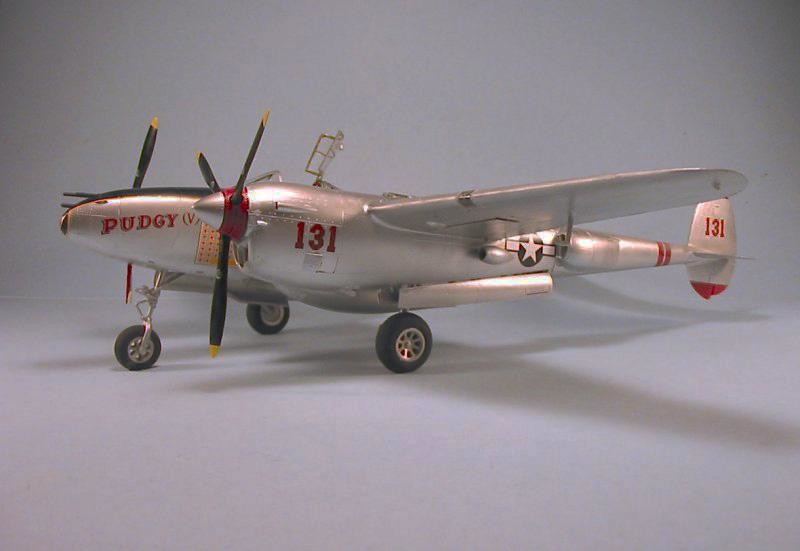
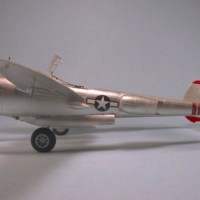

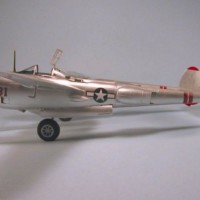

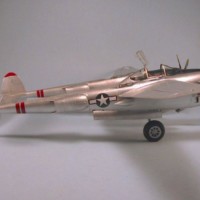
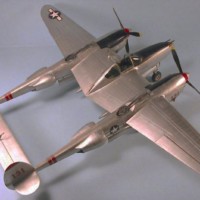
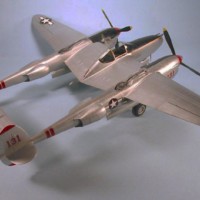
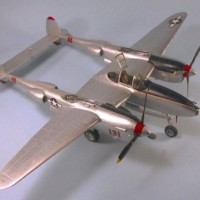
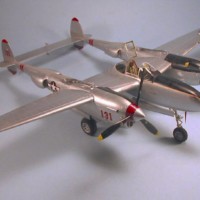
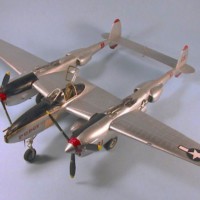
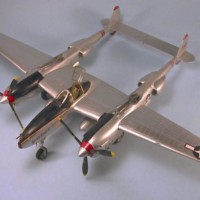
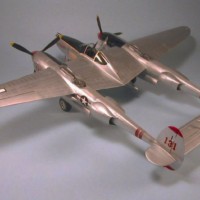
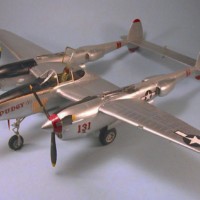
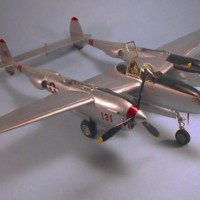
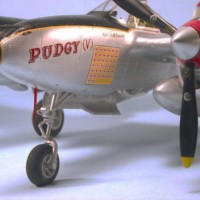
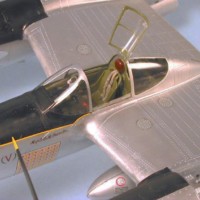
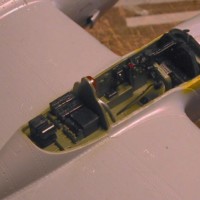
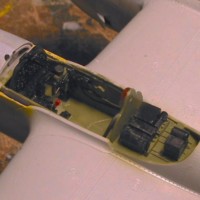
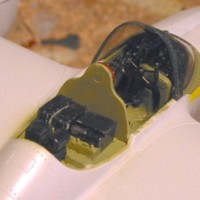
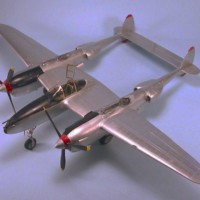
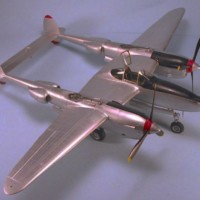
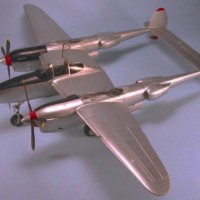
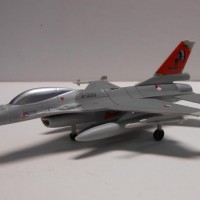
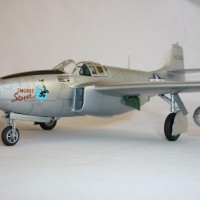
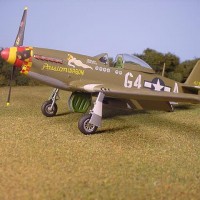
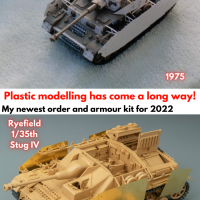
Nice job, Tom (and nose high, too).
Powerfully told, and absolutely gorgeous airplane. How did you paint this one, Tom?
Talon acrylic metalizer paint. No longer in production. If I was doing it today it would be Vallejo acrylic metalizer.
Simply remarkable finish.
Beautiful P-38, Tom! Nice series of builds.
Tom, great job on the P-38 builds. I like this one the most.
Ken
Tom, I Think I'm about to crack! What's the best 1/48th kit? Or should I wait in hope of an Airfix fix?
People who can't find the zipper on their fly with both hands on a clear day complain that the Hasegawa kits are "too hard." I never had a problem (but then again I built biplanes when I was 10 because I didn't know they were "hard" so I just did them). I think the Hasegawa kits are better than the Academy (unless you can't touch your nose with your foreginger 3 times in succession).
Paul, in 48th, either the Hasegawa or the Academy, with the older Monogram at third place. The Academy isn't as detailed, but is easier to assemble. Monograms is from the '60s, and the oldest of them all.
Almost forgot, Hobbyboss has one where the nacelle and booms are already assembled for you. I saw one in the box, so I don't know how it stacks up with the others. I was too stunned, to see the thing was 2/3 assembled! Boom alignment is the make or break on any P-38, and the horizontal stab between the booms.
The Hobby Boss kit is the easiest, but you need a re4sin cockpit and vacuform canopy.
Thank you Bernard, and Tom. I'm usually OK with my zipper - I'll find the Hasegawa kit.
Really nice P-38 Lightning.
I agree with Ken, this one looks the coolest.
Great work and beautiful finish!